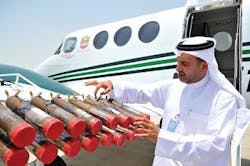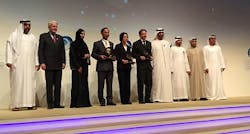Efforts in the United Arab Emirates (UAE) to develop cloud seeding have moved forward following the award of a $5 million grant.
Cloud seeding, also known as rain enhancement, works by dispersing – normally by a small aircraft - natural salts such as potassium chloride and sodium chloride into clouds to encourage rainfall.
When a suitable cloud is identified, salts are dispersed into the cloud with the aim to help droplets cluster until they are heavy enough to fall as rain drops.
It is hoped rain enhancement could provide up to 5% of water supplies.
It was in January 2015 when the UAE initiative began, overseen by the National Centre for Meteorology and Seismology (NCMS). Since then, 110 cloud seeding test flights have been launched.
Previous cloud seeding efforts have been successful. In April 2013 monthly rainfall in the Al Quaa region of Abu Dhabi was 136mm following cloud seeding. This compared to an average of 29.9mm between 2003 and 2014 without rain enhancement.
In its October-November edition, WWi magazine included a feature from Alya Al Mazroui, program manager for the UAE Research Program for Rain Enhancement Science (UAEREP), detailing ambitions of the plan (read article).
As part of the Abu Dhabi Sustainability Week, a $5 million grant was awarded to research groups from Japan, the UAE and Germany to help move the cloud-seeding related research forward.
The three prize-winning scientists leading the research teams that share this cycle’s grant of US$5 million include:
- Masataka Murakami,visiting professor from the Institute for Space-Earth Environmental Research, Nagoya University (Japan), for his work on precipitation enhancement in arid and semi-arid regions.
- Linda Zou, professor of chemical and environmental engineering from the Masdar Institute of Science and Technology (UAE), for her work on using nanotechnology to accelerate water condensation.
- Volker Wulfmeyer, managing director, professor, and chair of physics and Meteorology at the Institute of Physics and Meteorology in the University of Hohenheim (Germany), for his work on cloud seeding optimisation.
Elsewhere the US state of Texas started “rainmaking” efforts in the 1950s to combat drought and Israeli water company Mekorot claimed to have increased rainfall by 10%-15% by using similar rain enhancement methods.
Prize winners: (from right to left) Dr. Abdullah Al Mandoos, Director of the National Center of Meteorology and Seismology, His Excellency Rashid Al Ameri Deputy Chairman of the Board of Trustees of the National Center of Meteorology and Seismology, His Excellency Eng. Suhail Mohamed Faraj Al Mazrouei UAE Minister of Energy, His Excellency Dr Sultan Ahmed Al Jaber, Minister of State and the UAE Special Envoy for Energy and Climate Change, Volker Wulfmeyer, Managing Director, Professor, and Chair of Physics and Meteorology at the Institute of Physics and Meteorology in the University of Hohenheim in Germany, Linda Zou, Professor of Chemical and Environmental Engineering from the Masdar Institute of Science and Technology in UAE, Masataka Murakami, Visiting Professor from the Institute for Space-Earth Environmental Research, Nagoya University in Japan, Alya Al Mazroui, Program Manager of the UAE Research Program for Rain Enhancement Science, His Excellency Ólafur Ragnar Grímsson President of the Republic of Iceland, His Excellency Dr. Rashid Ahmed Bin Fahad, UAE Minister of Environment and Water.
###
Read more





